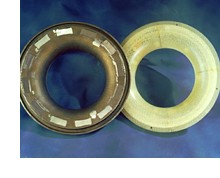|
Allied Signal Aerospace
|
Stereolithography and QuickCast provide the winning combination for meeting critical
deadlines in AlliedSignal's development of the TFE 731-20 Turbo Fanjet Engine.
"New engine programs are lengthy and expensive -- RP provides an ideal tool to get our
products to market faster."
- Michael Hyduke, Manufacturing Engineering Sciences Supervisor II, AlliedSignal Aerospace
|

|
The Challenge
Meeting a critical deadline to develop a new engine teamed AlliedSignal
with stereolithography's new QuickCast system to produce a turbo fanjet
engine for a Lear 45 Business Aviation Jet. Metal castings, a major portion
of the engine, can take up to eight months to produce. To shorten the
production time of the casting pattern, Allied turned to rapid prototyping
(RP) for generation of an impeller compressor shroud engine component.
This part is the static component that provides the seal for the high-pressure
compressor in the engine. Three different designs were required for cold
rig, hot rig and first engine to test. With its very complex geometries,
would the part meet its rigorous test requirements? A cross section in
the hack of the compressor shroud made the part very hard to build. Would
RP have the ability to produce such a difficult design?
Meeting engine test schedules was critical and budget concerns were at a premium.
The Results
Faced with rapidly approaching deadlines, two RP processes were applied in tandem through
representative service bureaus to build the shroud in efforts to quickly
produce accurate castable patterns. 3D's Technology Center turned to QuickCast, the proprietary
building system for direct production of investment casting patterns
using stereolithography (SL) technology. QuickCast and SL proved to have the edge in the following
areas:
- More durable patterns
- Improved accuracy
- Better surface finish
- Larger one-piece patterns
Moreover, the alternate RP technology was unable to maintain tolerances or arrive at the foundry
intact. In fact, the pattern generated by QuickCast was so accurate that a design revision error
in the assembly fixture was easily detected.
Use of QuickCast patterns for casting the nickel-base shroud reduced engine
development time for this critical path component, slashing the production
casting time by 8-10 weeks. A savings of $50,000 for tooling in the three
design iterations was also realized.
The Process
AlliedSignal developed the CAD file for the shroud and forwarded the file
to Precision Castparts Corp. (PCC), a foundry located in Portland, Oregon.
PCC then created a CAD solid model of the gating and sent both files,
converted to .STL file formats, to the Technology Center. After merging
the .STL files, the Tech Center built the QuickCast shroud, complete with
gatings, on their SLA 500. The completed pattern was then sent on to Precision
Castparts to produce the metal casting.
The SLA gated pattern was processed through flash-fire without autoclave, since there was very
little wax to remove. The end result was a precision shell investment cast metal part produced
directly from a stereolithography generated pattern, bypassing the traditional requirements for
expensive and time consuming hard tooling.
The Tools
- Computervision CADDS 4X software
- SLA 500 with Cibatool SL 5180
- QuickCast release 1.0 software
Company Profile
Headquartered in Phoenix, Arizona, AlliedSignal Aerospace Company is a leader in the production
of propulsion engines for business aviation and regional airlines, with emerging business across
a broad front of new military and commercial applications. The world-class line of turbine
propulsion engines built in Phoenix includes turboprop, turbofan, and turboshaft units for
commercial and military aircraft, and turbojet engines for expendable military vehicles.
|



